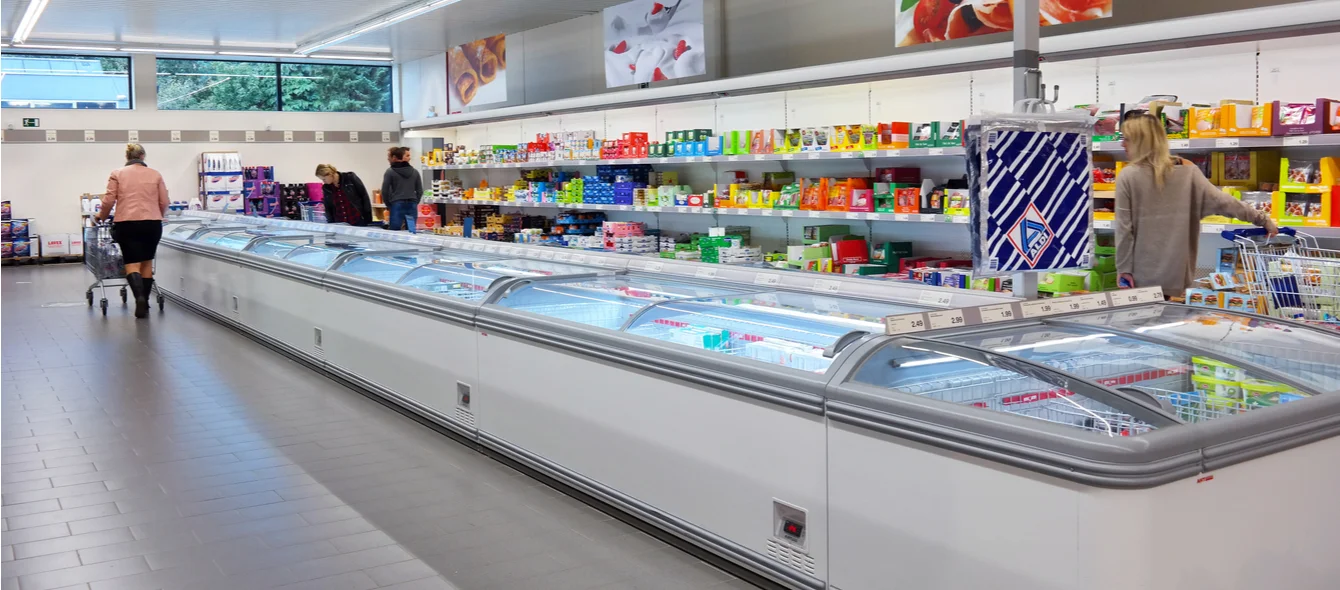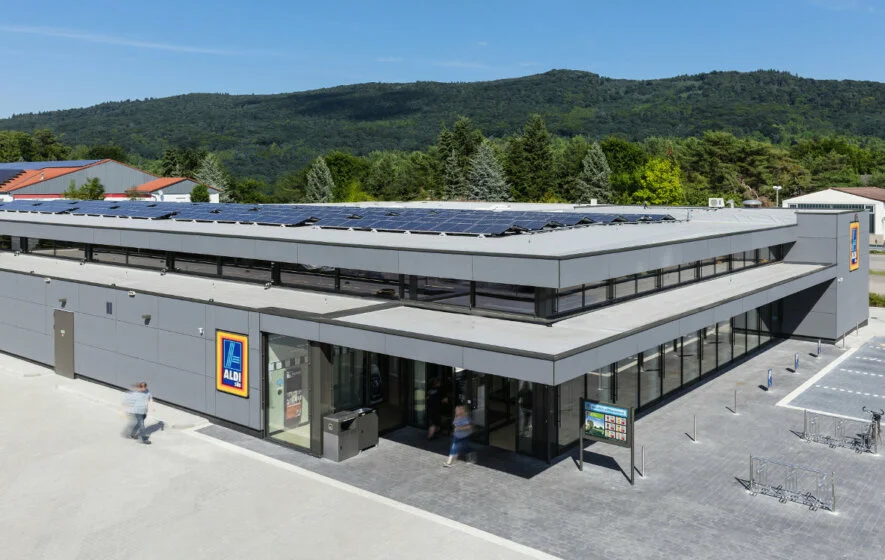In the first instalment of the series, en:former showed how large digital corporations are reducing their emissions and increasingly turning to renewables. This second part will look at an industry that has become somewhat side-lined in the discussion: the food retail sector. Supermarkets and discount stores need a lot of energy, especially when it comes to electricity for chilling food. Therefore, companies are striving to reduce their energy consumption and associated emissions.
Forty-six terawatt hours or around 165 terajoules – that’s how much electricity and heat the almost 55,000 supermarkets and discount stores in Germany need every year. This means that the food retail sector consumes almost as much energy as the German steel industry with its huge blast furnaces. Freezing food, in particular, requires vast amounts of electricity.
In view of this high demand, Germany’s major supermarket chains are working to reduce their energy consumption and are opting to increasingly rely on renewable energy. On the one hand they want to cut costs, but on the other hand they are also looking to reduce emissions associated with energy consumption, and many traders in other European countries are following suit.
More efficient cooling reduces power consumption
And they have been able to record their first successes: Electricity consumption per square metre of shop floor per year is continuously decreasing for all supermarket chains in Germany, Austria and Switzerland, as proven by the latest figures from the Energy Management in Retail 2019 study conducted by the EHI Retail Institute, a research and consulting institute for the retail industry.
“So much is changing in the industry, and the level of professionalism has increased enormously over the past ten years,” says Benjamin Chini, project manager for energy management at EHI. The institute has been supporting trade in German-speaking countries with regard to energy-related issues since 2008. While the transition to LED lighting has been a central focus in recent years, the next issue on the agenda will be energy monitoring that is as accurate as possible. This is made possible with the help of intelligent power meters (smart meters) that record how much electricity is consumed at any given point in the system. “This transparency holds great potential, which all supermarket chains in Germany have really profited from,” explains Chini.
Energy consumption food and non-food 2019 in comparison
in kilowatt hour per square meter of sales floor per year, basis previous year, (Source: EHI-Studie Energiemanagement im Einzelhandel 2019).In what is referred to as the food sector, the EHI’s analysis shows that 79 percent of total energy costs are accounted for by electricity and 21 percent by thermal energy. According to the EHI study, this amounted to 51.18 euros per square metre of shop floor in 2018, thus coming in 2.21 euros lower than in 2017. Overall, the retail chains also consumed 1.2 percent less electricity than in the previous year, with consumption falling slightly from 321 to 317 kWh per square metre of shop floor. These savings are attributable to the freezer systems, which are now almost completely enclosed, along with the installation of doors on refrigeration systems and the change in lighting. A full 40 percent of the supermarkets included in the study have already switched to LED technology.
Power consumption by type of farming
in kilowatt hour per square meter of sales floor per year, basis previous year, (Source: EHI-Studie Energiemanagement im Einzelhandel 2019).REWE as the pioneer and ALDI Süd with the most photovoltaic systems
The pioneer in Germany is undoubtedly REWE Group, which was the first supermarket retailer to use only certified water, wind or solar-based electricity in its stores nationwide. REWE has also set itself the goal of halving its greenhouse gas emissions per square metre of shop floor by 2022 versus 2006. By the end of 2018 the Group had already achieved a 43 percent drop. These savings have been achieved by reducing the amount of electricity used for lighting, optimising refrigeration, heating and ventilation systems and using climate-friendly refrigerants.
Self-generated electricity from photovoltaics is also becoming more and more interesting to supermarket chains. Although REWE Group had 46 photovoltaic systems on the roofs of its stores by the end of 2017, Aldi-Süd (in German) has already mounted PV systems on over 1,300 of its stores. All in all, they produce almost 130 million kilowatt hours of electricity per year, which is equivalent to the consumption of 36,000 three-person households. Other technologies such as a system for heat recovery from refrigeration systems or geothermal energy for heating or cooling buildings are also being tested by Aldi Süd.
Aldi-Süd has 1300 PV systems on its roof, which means that almost 130 million kilowatt hours of electricity are produced annually, the equivalent of the consumption of 36,000 three-person households.
Carrefour relies on solar, Tesco turns to wind
Things are also shifting in other European countries. In France, large retail groups such as Carrefour, E. Leclerc and Auchan are planning on equipping their buildings with solar systems. In spring 2019, Carrefour entered into a partnership with the photovoltaic company Urbarsolar, to successively mount photovoltaic systems on the parking lots of Carrefour outlets in order to supply the supermarkets with electricity. However, to date only just under 50 markets have been equipped with solar panels.
The British group Tesco, on the other hand, relies on wind. The largest food retailer in the UK has concluded what is referred to as a Power Purchase Agreement (PPA) with energy supplier EDF Renewables. Tesco receives electricity from two Scottish onshore wind farms with a total capacity of 96 megawatts. In addition, the roofs of the supermarkets are to be successively equipped with solar systems.
Tesco hopes to save 90,000 tons of carbon dioxide annually, which would be equivalent to the emissions of 15,000 cars per year. By 2030, Tesco wants to supply its outlets exclusively with electricity from renewable sources. According to Benjamin Chini, there is also already talk of Power Purchase Agreements for wind turbines in Germany: “But we are a long way from any kind of a decision as of yet.”
The challenges of older sites
Overall, Benjamin Chini praises the efforts of the sector. Particularly when building new supermarkets, retailers are able to plan resource-efficiently. “The older sites, in fact, present the real challenge,” Chini elaborates. For when it comes to well-established inner-city supermarkets, it is simply not as easy to mount a photovoltaic system on the roof, for example, because it may be located on the ground floor of a residential building with several shareholders. In these cases, different tactics must be employed to save energy.
Sustainable energy and resource management is an important issue in supermarket chains’ investment planning: 53 percent of supermarket retailers in German-speaking countries alone have invested more than 25 million euros apiece in energy efficiency measures in the past five years. For 24 percent of the corporations, the investments total in some cases even well over 50 million euros.
“There’s still a ways to go, nobody should be resting on their laurels just yet”, says Benjamin Chini. For its next energy management study in the retail sector, EHI wants to see where there is still potential for savings and what other improvements are viable when it comes to refrigeration technology.


